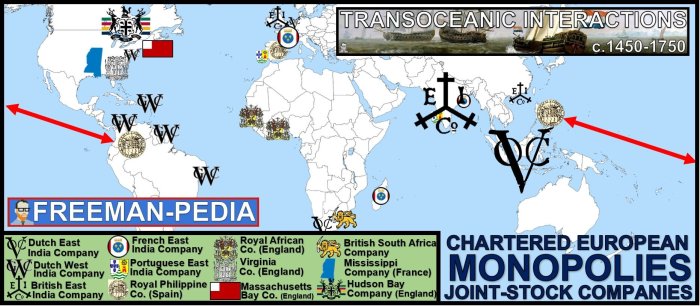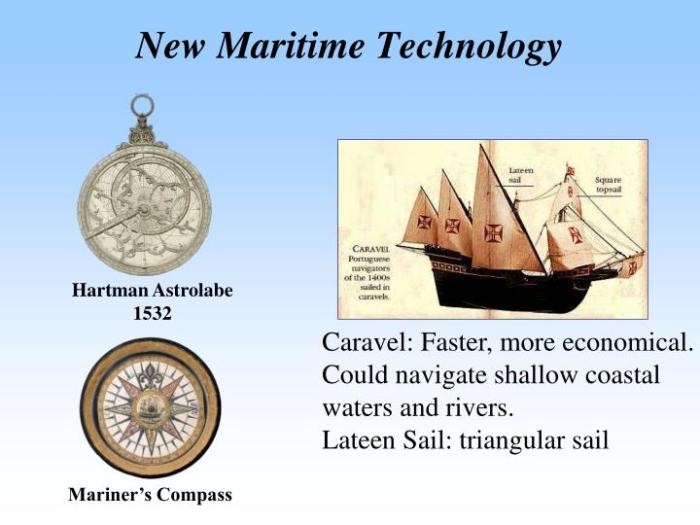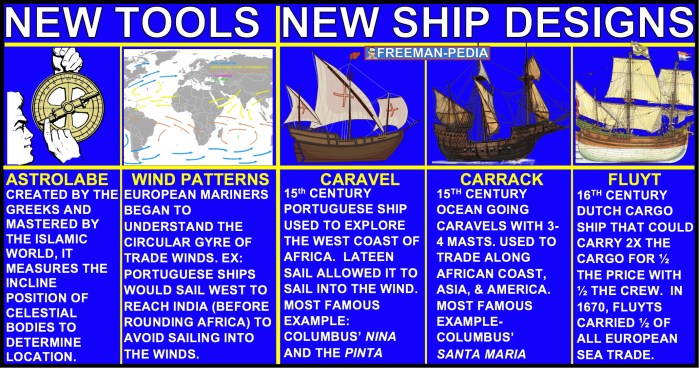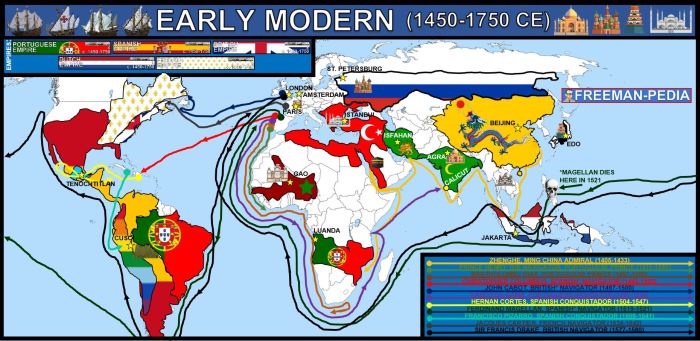Maritime technology 1450 to 1750 – Delving into the era of Maritime Technology from 1450 to 1750, this comprehensive exploration unravels the groundbreaking advancements that transformed maritime exploration and trade. Driven by a thirst for knowledge, resources, and global expansion, this period witnessed a surge of innovations that reshaped the world’s oceans.
From the evolution of shipbuilding techniques to the development of sophisticated navigational instruments, maritime technology flourished during this era, enabling sailors to venture further, navigate more accurately, and establish global trade networks that connected civilizations across vast distances.
Maritime Technology Advancements during the Period 1450-1750

The period between 1450 and 1750 witnessed a remarkable surge in maritime technology advancements, driven by the Age of Exploration and the quest for new trade routes and territories. These innovations revolutionized shipbuilding, navigation, and maritime warfare, enabling explorers to venture farther and with greater accuracy.
Key factors that fueled these advancements included the rise of scientific inquiry, the exchange of knowledge between different cultures, and the increasing demand for maritime trade and exploration. Governments and private individuals invested heavily in maritime research and development, leading to groundbreaking innovations that transformed the world of seafaring.
Improvements in Ship Design and Construction
One of the most significant advancements was the development of larger and more seaworthy ships. The caravel, a Portuguese invention, featured a triangular lateen sail that allowed for better maneuverability and windward sailing. The carrack, a larger and more robust vessel, provided increased cargo capacity and stability for long voyages.
Improvements in shipbuilding techniques also contributed to the enhanced performance of ships. The use of multiple masts and sails increased speed and efficiency, while advancements in hull design reduced drag and improved stability. These innovations enabled ships to travel longer distances and withstand rough seas, expanding the reach of maritime exploration and trade.
The Role of Shipbuilding Innovations
The period from 1450 to 1750 witnessed significant advancements in shipbuilding techniques and designs, which played a crucial role in the expansion of maritime exploration and trade. These innovations led to ships that were larger, more stable, and capable of sailing longer distances, contributing to the success of voyages of discovery and the establishment of global trade routes.
Hull Construction
Shipbuilders during this period made significant strides in hull construction, adopting new methods and materials to enhance the strength and durability of their vessels. The use of multiple layers of planking, known as carvel construction, provided greater rigidity and watertightness.
Additionally, the introduction of iron and copper sheathing on hulls reduced damage from marine organisms, extending the lifespan of ships.
Rigging and Sails
Advancements in rigging and sails enabled ships to harness wind power more effectively. The development of lateen sails, with their triangular shape and ability to catch wind from a wider range of directions, improved maneuverability and speed. Additionally, the introduction of multiple masts and the use of larger sails allowed ships to carry more cargo and travel greater distances.
Propulsion Systems
The period saw the gradual shift from oars to sails as the primary means of propulsion for large ships. This transition was driven by the need for greater efficiency and endurance on long voyages. Oars remained important for maneuvering in confined spaces and during calm conditions, but sails became the dominant form of propulsion for open-sea travel.
Innovative Ship Designs
These shipbuilding innovations culminated in the development of several innovative ship designs that played a pivotal role in maritime exploration. The carrack, with its high sterncastle and multiple masts, provided a stable and spacious platform for long-distance voyages. The galleon, a smaller and more maneuverable vessel, was well-suited for exploration and combat.
The fluyt, a Dutch merchant ship, was renowned for its large cargo capacity and efficient design, revolutionizing trade and transportation.
Navigational Advancements and Instruments

The period between 1450 and 1750 witnessed significant advancements in navigational instruments and techniques, revolutionizing maritime exploration and navigation. Advances in astronomy, cartography, and timekeeping played a crucial role in improving sailors’ ability to determine their location and course accurately.
Astronomical Navigation
The development of the astrolabe, quadrant, and cross-staff enabled sailors to measure the altitude of celestial bodies, primarily the sun and stars. By combining these measurements with knowledge of celestial bodies’ positions and movements, navigators could determine their latitude with greater precision.
Cartography
The introduction of printed maps, such as the portolan charts, provided sailors with detailed representations of coastlines, harbors, and sea routes. These charts allowed for more accurate planning and tracking of voyages. Additionally, the development of the Mercator projection in the 16th century revolutionized mapmaking by preserving the correct shape of landmasses, making it easier for sailors to plot courses.
Timekeeping
Accurate timekeeping became essential for determining longitude. In the 17th century, the invention of the pendulum clock by Christiaan Huygens provided a reliable and portable timekeeping device. By comparing the time at their known location with the time at sea, sailors could calculate their longitude, a major breakthrough in navigation.
Other Instruments
Other important navigational instruments included the compass, which indicated direction, and the log line, which measured the ship’s speed. The development of the sounding lead and echo sounder allowed sailors to determine the depth of water, crucial for avoiding shallows and navigating safely.These
advancements in navigational instruments and techniques transformed maritime exploration and trade. Sailors could now venture farther and navigate with greater accuracy, leading to the discovery of new lands, the expansion of trade routes, and the establishment of global empires.
The Influence of Scientific Explorations
Scientific expeditions and voyages of discovery played a pivotal role in driving maritime technology advancements during the period 1450-1750. The quest for new knowledge and resources spurred the development of specialized ships and instruments, enabling explorers to venture into uncharted waters and make groundbreaking discoveries.
Specialized Ships for Scientific Exploration
The need to accommodate scientific equipment and personnel led to the design of specialized ships. These vessels incorporated features such as spacious cabins for laboratories, libraries, and observatories. For instance, the HMS Challenger, launched in 1872, was equipped with a steam engine, a large deck for scientific work, and specialized laboratories for studying marine biology, geology, and oceanography.
Navigational Advancements for Scientific Explorations
Navigational advancements were crucial for scientific expeditions. The development of the compass, astrolabe, and quadrant allowed explorers to determine their position and course more accurately. Additionally, the invention of the chronometer in the 18th century enabled navigators to calculate longitude precisely, a significant breakthrough for long-distance voyages.
Instruments for Scientific Explorations
Scientific instruments played a vital role in collecting and analyzing data during expeditions. Microscopes, telescopes, and thermometers allowed explorers to observe and study marine life, celestial bodies, and oceanographic conditions. For example, the microscope enabled the discovery of microorganisms and revolutionized the field of marine biology.
Examples of Scientific Expeditions
Numerous scientific expeditions contributed to maritime technology progress. Ferdinand Magellan’s circumnavigation of the globe (1519-1522) demonstrated the importance of accurate navigation and led to the development of new charts and instruments. James Cook’s voyages in the Pacific (1768-1779) further refined navigational techniques and resulted in the discovery of new lands and species.
The Challenger Expedition (1872-1876) marked a turning point in oceanography, collecting vast amounts of data on marine life and ocean currents.
Impact on Maritime Trade and Exploration

Maritime technology advancements during the period 1450-1750 revolutionized global trade and exploration. Enhanced ship designs, navigation, and instruments enabled longer voyages, expanded trade routes, and facilitated the Age of Exploration.
Expansion of Trade Routes
Improved ship designs and navigation allowed for longer voyages and the expansion of trade routes. European explorers and traders ventured beyond familiar waters, establishing new trade connections with Asia, Africa, and the Americas. These new trade routes led to an exchange of goods, ideas, and cultures, fostering economic growth and cultural exchange.
Age of Exploration, Maritime technology 1450 to 1750
The maritime technology advancements of this period played a crucial role in the Age of Exploration. Advanced ships, such as the caravel and galleon, enabled explorers like Christopher Columbus, Vasco da Gama, and Ferdinand Magellan to embark on daring voyages that reshaped the world map and expanded European influence.
Establishment of Global Trade Networks
The maritime technology advancements facilitated the establishment of global trade networks. European powers established trading posts and colonies in various parts of the world, creating a complex network of trade routes that connected different continents. This global trade network allowed for the exchange of goods, resources, and ideas, contributing to the development of a global economy.
Regional Variations in Maritime Technology

During the period 1450-1750, maritime technology advancements exhibited significant regional variations, influenced by factors such as geography, resource availability, and cultural traditions. Different regions adopted and adapted maritime technologies to meet their specific needs, resulting in a diverse array of vessel designs, navigation techniques, and shipbuilding practices.
Geographic Influences
Geographic factors played a crucial role in shaping maritime technology development. Coastal regions with access to abundant timber resources, such as the Baltic Sea and the Mediterranean, developed advanced shipbuilding techniques and produced seaworthy vessels. In contrast, regions with limited timber resources, such as the Arabian Peninsula, relied on smaller, lighter boats constructed from locally available materials.
Resource Availability
Resource availability also influenced maritime technology advancements. Regions with access to iron and other metals developed advanced forging techniques and produced ships with iron fittings and armaments. In areas lacking metal resources, such as Southeast Asia, ships were often constructed using wood and other natural materials.
Cultural Traditions
Cultural traditions and maritime practices varied significantly across regions. In Europe, the development of large, ocean-going vessels was driven by the need for exploration and trade. In East Asia, smaller, maneuverable ships were preferred for coastal trade and fishing.
Examples of Regional Adaptations
- Northern Europe:Cogs, sturdy sailing ships with a shallow draft, were widely used for trade in the Baltic Sea.
- Mediterranean:Galleys, powered by both sails and oars, were the dominant vessels in the Mediterranean, used for both warfare and trade.
- Arabian Peninsula:Dhows, traditional Arab sailing vessels, were designed for long-distance trade and exploration in the Indian Ocean.
- Southeast Asia:Junk ships, with their distinctive sails and watertight compartments, were widely used for trade and transportation in Southeast Asian waters.
Legacy and Lasting Impact: Maritime Technology 1450 To 1750
The maritime technology advancements during the period 1450-1750 left a lasting impact on maritime exploration, trade, and naval warfare. These innovations revolutionized navigation, shipbuilding, and maritime technology, shaping the course of human history.
One of the most significant legacies of this period was the development of accurate navigation instruments. The invention of the compass, astrolabe, and quadrant allowed sailors to determine their position at sea with greater precision, enabling them to venture further from shore and explore new territories.
Shipbuilding Innovations
Advancements in shipbuilding techniques also played a crucial role in maritime exploration. The development of larger and more seaworthy vessels, such as the caravel and the galleon, enabled sailors to undertake longer and more ambitious voyages.
Scientific Explorations
The maritime technology advancements of this period facilitated the Age of Exploration. Explorers such as Christopher Columbus, Vasco da Gama, and Ferdinand Magellan used these innovations to embark on groundbreaking expeditions, expanding European knowledge of the world and leading to the establishment of global trade routes.
Maritime Trade and Exploration
The improvements in maritime technology also transformed maritime trade. The development of faster and more efficient ships allowed for the transportation of goods over greater distances, fostering economic growth and cultural exchange between different regions of the world.
Naval Warfare
The advancements in maritime technology had a profound impact on naval warfare. The development of larger and more powerful warships, equipped with advanced weaponry, revolutionized naval combat. These innovations led to the rise of powerful navies and the establishment of maritime empires.
Modern Maritime Technology and Navigation
The legacy of the maritime technology advancements of the period 1450-1750 continues to shape modern maritime technology and navigation. Many of the principles and techniques developed during this period remain fundamental to navigation and shipbuilding today.
The development of electronic navigation systems, such as GPS and radar, has further enhanced the accuracy and efficiency of navigation. However, the fundamental principles of celestial navigation, developed during the Age of Exploration, continue to serve as a backup in case of electronic failure.
The lasting impact of the maritime technology advancements of the period 1450-1750 is undeniable. These innovations revolutionized maritime exploration, trade, and naval warfare, and their legacy continues to shape the world we live in today.
Essential Questionnaire
What were the key factors driving maritime technology advancements during this period?
The quest for new knowledge, resources, and trade opportunities, coupled with scientific curiosity and the desire to explore the unknown, fueled the rapid development of maritime technology during this era.
How did shipbuilding innovations enhance ship performance and safety?
Advancements in hull design, rigging, and propulsion systems, such as the development of the carrack and the lateen sail, improved ship stability, speed, and maneuverability, allowing sailors to undertake longer and more daring voyages.
What were some of the most important navigational instruments developed during this era?
The astrolabe, quadrant, and magnetic compass revolutionized navigation, enabling sailors to determine their latitude, longitude, and direction more accurately, greatly enhancing their ability to traverse vast oceans.
How did scientific expeditions contribute to maritime technology progress?
Voyages of discovery, such as those led by Christopher Columbus and Vasco da Gama, spurred the development of specialized ships and instruments to meet the challenges of exploring uncharted waters and navigating unknown coastlines.